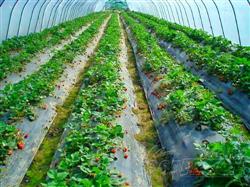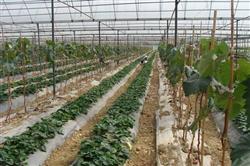Pollution-free cultivation techniques of Strawberry in plastic greenhouse

(1) Varieties with early flower bud differentiation, shallow dormancy and good cold resistance in low temperature season shall be selected, such as Chunxiang, Fengxiang, Lihong, Mingbao, Jingbao, Nufeng, Baojiaozaosheng, etc. (ii) Cultivate strong seedlings 1. Select mother plants. From March to April of that year, the plants with vigorous growth, good inflorescence and fruit, few abnormal fruits, developed root system and no diseases and insect pests were selected from strawberry production sheds as mother plants. Planting in a special nursery, cultivating seedlings stolon. 2000- 3000kg organic fertilizer and 10kg compound fertilizer are applied per mu in nursery. 2 meters wide, planting row spacing 1 meter, plant spacing 0.3- 0.4 meters, after survival early topdressing nitrogen fertilizer, keep the soil moist, appear inflorescences to all be removed, in order to facilitate the growth of stolons. 2. Nurturing seedlings in nutrient pots. Cultivate excellent stolons. In the first half of May, the mother plant begins to sprout stolons. In order to cultivate strong seedlings, 4-5 stolons are generally reserved for each mother plant, and 2-3 excellent seedlings are propagated on each stolon. In order to promote the early differentiation of flower buds, it is also necessary to adopt a nutrition pot to raise seedlings. From late May to late June, under the condition of not cutting stolons, transplant the rooted stolons with two leaves to a plastic nutrition pot (specification: 10- 12cm × 10cm) filled with nutrient soil. When all seedlings survive and the number of seedlings reaches the requirement, cut off the stolons, and then move the seedlings in the nutrition pot to the nursery shed. Strengthen fertilizer and water management, water frequently, keep the basin soil moist and reduce the soil temperature. Topdressing nitrogen fertilizer, starting from the first and middle of July, once every week or so, to the middle of August. In order to promote flower bud differentiation, shading treatment covered with black cold yarn from mid-August to mid-September can promote flower bud differentiation 5-10 days earlier. (iii) Colonization and field management The colonization period is from mid-late September to early October. Half a month before planting, apply organic fertilizer 3000-5000 kg, calcium superphosphate 40-50 kg and compound fertilizer 50 kg per mu. Open deep grooves and build high ridges. Make 5-6 ridges in 6-meter-wide greenhouses. The ridge width is 1-1.2 meters. Double rows are planted in each ridge. The row spacing is 25 cm ×18 cm. Water is poured once after planting. Pay attention to fertilization, irrigation, picking old leaves, picking axillary buds, intertillage and weeding after slow seedling. Cover plastic film in late October, and pollinate varieties should be allocated in addition to the main varieties in the shed. In principle, there should be no less than 3-4 varieties, and the distance between two varieties should not exceed 25 meters. (iv) Temperature management: Immediately after planting, raise the greenhouse temperature to 30 ° C, and at the end of October, when the average temperature drops to 16 ° C, keep the temperature for an appropriate period. At the initial stage of heat preservation, 28-30℃ in the day and 12℃ at night; at the bud stage, 25-28℃ in the day and 10℃ at night; when the fruit grows to harvest, it is not higher than 25℃ in the day and 3-5℃ at night. When more than 30% flower buds appeared after 3 days in greenhouse, spraying 5-10 mg/kg gibberellin solution 5 ml to each plant, especially spraying the heart leaves, could make the terminal inflorescence bloom ahead of time. In December, the temperature drops sharply. If the night temperature in the greenhouse drops below 0℃, it should be kept warm again. Use a small arch shed inside the shed, or add a hanging film inside the shed. (v) Water and fertilizer management Water is generally given once a week to keep the soil moist. The key measure to the growth of strawberry is to ensure the water supply in the initial stage of insulation, fruit growth stage, peak harvest stage and after harvest interval. Apply topdressing 1-2 times from planting to the beginning of heat preservation, especially once before laying plastic film, and use compound fertilizer 8-10 kg per mu. Fruit growth stage and early harvest stage once each, with 400-500 times of compound fertilizer drip irrigation or irrigation. Apply once in mid-February before resuming growth. Apply twice from flower bud axil to fruit enlargement in early spring. A total of 7-8 times of fertilizer, master less frequent application, irrigation of liquid fertilizer 1500-3000 kg per mu each time. In addition, from budding stage to flowering stage, boric acid, copper sulfate, ammonium molybdate or plant power 2003 can be sprayed on leaves for 2-3 times. (vi) Auxiliary pollination: bees are used for auxiliary pollination. Before the terminal inflorescence opens at the end of November, a box of bees is kept in each shed. After the strawberry blossoms, artificial pollination can be carried out with a new brush. Pollinating time is 9:00-11:00 in the morning, 2:30-4:30 in the afternoon, and the full bloom is carried out once every 2 days. (vii) Flower thinning and fruit thinning. Each strawberry plant generally has 5-6 inflorescences. In the bud differentiation stage before flowering, the flower buds of high nodes are properly thinned, and the average number of fruits per inflorescence does not exceed 12. Fruit thinning is when young fruit is green, thinning abnormal fruit, diseased fruit and late floret small fruit. (viii) Artificial supplementary lighting: Artificial supplementary lighting is used to create long-day conditions to inhibit strawberries from entering dormancy. Incandescent lamps are installed in the shed from late November to mid-February of the following spring. One 100-watt incandescent lamp is hung every 4 meters and is set 1.5 meters above the ground. The time is from 17:00 to 23:00 every night at sunset, or from 2:00 a.m. to 8:00 a.m. Timely ventilation, beat old leaves, reduce irrigation times, achieve humidity reduction in the shed. The temperature in the greenhouse rises rapidly in sunny days, and ventilation can be carried out at 28℃. (ix) The main pest control is red spider. During the occurrence period, 800 times solution of acaritin and 1000 times solution of killing can be alternately sprayed for 6 times. In the middle of March, gray mold is easy to occur. 50% carbendazim 1000 times solution and 70% thiophanate-methyl 800 times solution can be sprayed alternately for 2 consecutive times, once every 7 days. Stop the medication 10 days before harvest.
- Prev

Strawberry interplanting has high economic benefit.
1. Interplanting Fengxiang or Mingbao strawberries in greenhouse strawberry fields ended in early September, covered with greenhouse film before the cold spell from the end of October to early November, plus straw curtain in winter, covered with plastic film and small shed, and other management was the same as greenhouse strawberries. Tomato and vegetable pepper seedlings were raised on November 20 and sold out before April 20 of the following year. March 5.
- Next

Field management should be strengthened after strawberry harvest.
After strawberry berry harvest, the plant entered the vigorous growth stage, a large number of stolons occurred, new stem branches accelerated, and new young plants formed, which was the second peak period of vegetative growth in the whole year. Subsequently, as the temperature gradually increased, growth began to slow down, around the beginning of autumn, flower buds began to differentiate and then transferred to reproductive longevity.
Related
- Moge, come on! The staff of the peasant association in the producing area of cantaloupe were frightened when the crowd gathered.
- Causes and Solutions of low Fruit setting rate of Apple
- Symptoms and control measures of passion fruit virus disease
- Fruit growing lesson: how do apple orchards keep high yields?
- Can you build orchards in the mountains? What are the pros and cons?
- How to manage the coloring period of Crisson grape?
- This paper introduces the processing technology of two kinds of fig products.
- How much is a month for retired teachers in rural areas by 2020?
- How can strawberry planting increase sugar content? We should pay attention to management in many aspects.
- What are the cultivation techniques on how to improve the yield of golden fruit?

